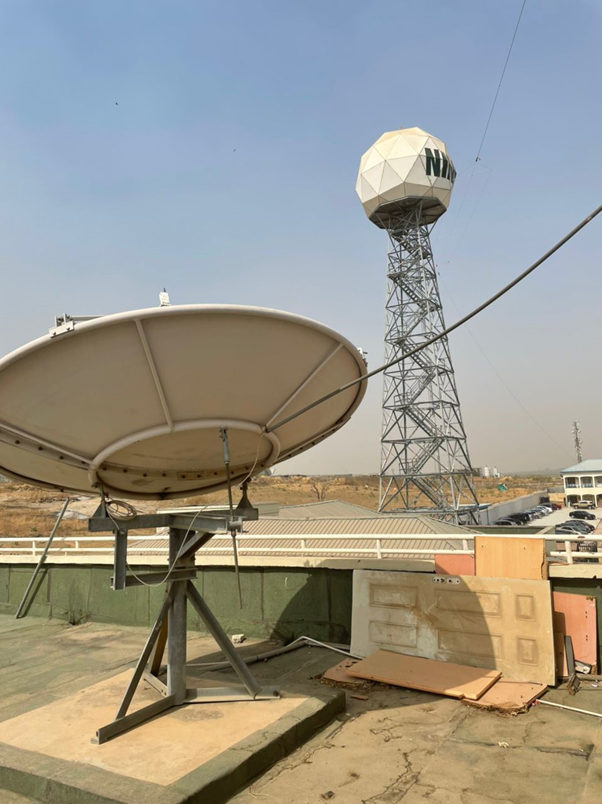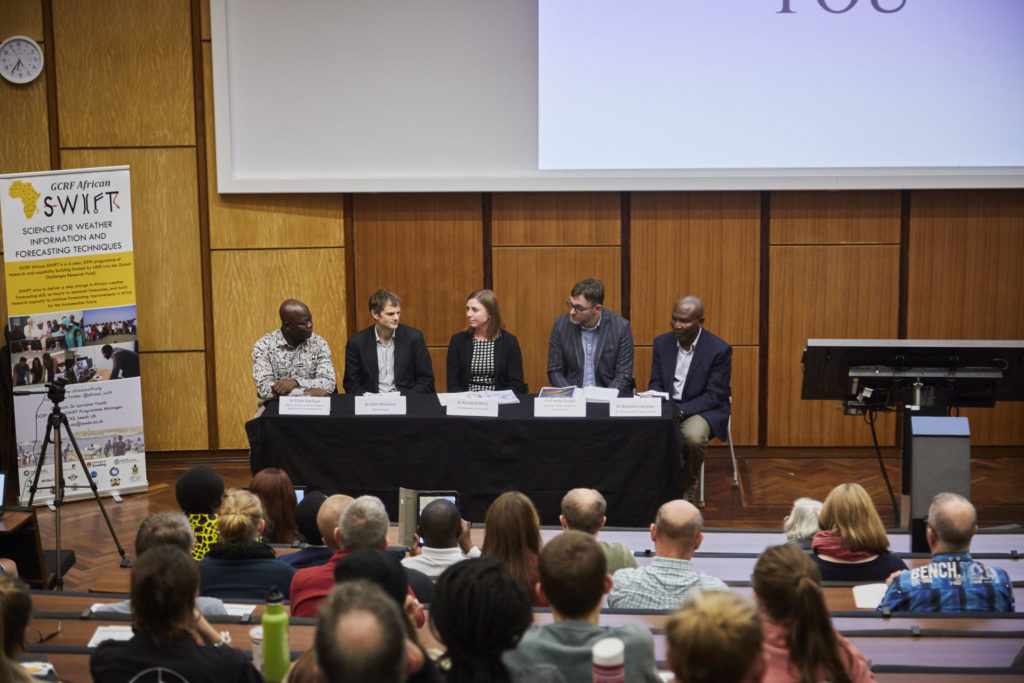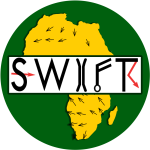By helping partner countries to make step changes in forecasting capacity, GCRF African SWIFT has made international organisations aware of the potential for improvements in African forecasting. This has already influenced policy in some cases and will in future raise the profile of African meteorology on an international level. SWIFT has worked collaboratively with the World Meteorological Organisation (WMO), who are a formal partner in the project, and is contributing to several international strategic efforts on forecast development policy. SWIFT has also worked with the European Organisation for the Exploitation of Meteorological Satellites (EUMETSAT) to use their products for nowcasting (0-6 hour forecasting) in Africa, and the success of this work has encouraged EUMETSAT to account for African users more strongly in their approach for exploitation of the next generation of satellites.
Practical, economic and societal impact/anticipated impact
Role of long-term international programmes in the legacy of the SWIFT project
However successful their work, short-term funded projects like SWIFT (2017-2022) cannot in isolation ensure that their work will have a lasting impact and legacy. Once a project is completed and its funding ceases, the work it has done may also cease, and after a few years there might be little trace of the impact of the work. On the other hand, a project like SWIFT does represent an opportunity to look at old problems differently, and to influence the long-term strategy of the international community in ways which may have a lasting effect. From its inception, the SWIFT project has attempted to face up to these aspects of its relationship with longer-term programmes, through partnership with the WMO and its World Weather Research Programme (WWRP) in particular.
The WWRP has been a formal project partner in SWIFT since the start of the project, meaning that the project’s direction has been steered by WMO, and its outcomes have, in turn, been communicated back to WMO. SWIFT’s research programme has also been able to explore new approaches to old problems. Having the freedom to work directly on the implementation of solutions, it could also be said that SWIFT has disrupted assumptions regarding the direction of the weather forecasting enterprise in Africa. Estelle de Coning, Head of the WWRP, has remarked that SWIFT has shown how things can be done: the project has provided important examples of the application of new nowcasting and forecasting techniques.

SWIFT has also championed the value of academic-operational partnerships within Africa, to ensure long-term legacy of its work. Influencing academic programmes in Africa, through their long-term research activities and through the hundreds of students they train every year, has a lasting impact on capacity and capability in the continent. In the case of weather forecasting science, most operational forecasters are trained in partnering universities. In pushing along the level of development in operational forecasting practice in Africa, and embedding these advances into academic research and training in the universities, SWIFT has developed a template for local independent development of practice. Again, this work has been done in cooperation with the WMO, its regional training centres (RTCs) and with EUMETSAT’s training division.
Policy Briefs
SWIFT has worked together with the Kenyan forecast development organisation Forecast-Based Preparedness Action (ForPAc) to produce a White Paper1 documenting recommendations for future improvements in African forecasting. Three shorter policy briefs focusing on specific aspects were produced during this process: one on nowcasting (0-6 hour forecasting)2, one on producing sub-seasonal to seasonal (2-4 week) forecasting products3, and one general report about forecasting development in Africa4. A fourth policy brief on embedding co-production into standard procedures is in progress and is due to be finished shortly after this article is published. The reports give clear recommendations supported by the broad experiences of SWIFT partners in African forecasting. They make a bold claim that African forecasting can be significantly improved in the next 5 years if proper support is given.
Collaborations with EUMETSAT
Enhanced collaboration between EUMETSAT and African countries has the potential to further improve satellite services in Africa, which in turn will lead to better forecast products. The forecast methods using satellite products developed through SWIFT are all short range (nowcasting; 0-6 hours) and are used in a range of applications, so many people will benefit. SWIFT has worked collaboratively with EUMETSAT throughout the timeline of the SWIFT project, and the EUMETSAT Support to Nowcasting and Very Short Range Forecasting (Nowcasting SAF) software has been installed in all SWIFT partner countries.
Prior to SWIFT, most of the African national meteorological and hydrological services were using satellite imagery products without enhancement for nowcasting applications provided by the Nowcasting SAF. Before the project began, EUMETSAT Nowcasting SAF was effectively installed only in a couple of national meteorological and hydrological services in Africa, and centres like ACMAD (the African Centre for Meteorological Applications for Development) had made attempts to install the software without success.
Through SWIFT, 5 operational forecasting services (including ACMAD) have installed the product (all the SWIFT partners that produce short-term forecasts operationally). This success across the SWIFT partnership has demonstrated that it will be possible to extend these solutions to many more countries across Africa in future.

The increased use of the nowcasting product has already had direct applications, the impact of which has been noticed by EUMETSAT. For example, the products have been used to coordinate responses to locust swarms, to give early warnings of heavy rain and to disseminate information on storms through an app, FASTA (Forecasting African Storms Application), which is already publicly available in Kenya
The impact has encouraged EUMETSAT to consider practical ways of improving its services in Africa. The new generation of satellites developed by the organisation, known as Meteosat Third Generation (MTG), offers massive new opportunities in improved data provision, but the increased data volumes present a challenge for African organisations and networks, and without enhanced communication solutions may render existing systems unusable. Recognising these opportunities and challenges, EUMETSAT is working with African centres to find the best solutions in time for the new satellites that will be operational in a couple of years’ time. The Ghana Meteorological Agency (GMet) and the South African Weather Service (SAWS) are moving towards using a terrestrial, high-bandwidth cable-based solution to overcome such difficulties. Practical solutions like these are being discussed regularly between EUMETSAT and an African Expert Group on (satellite) data dissemination (RAIDEG). Best practice will be reported in the new WMO Guidelines for the use of satellite data for nowcasting in Africa.
Just as importantly, SWIFT has had an impact on training in EUMETSAT. The project has pioneered the use of “testbeds”, intensive short term forecast development projects involving both researchers and operational users, to implement EUMETSAT products. According to Mark Higgins, Training Manager at EUMETSAT, “SWIFT demonstrates the value of the satellite data in operational meteorology in Africa, but equally important shows approaches that can be used to teach operational meteorologists how to use the data in their forecasting”.
SWIFT held two testbeds involving nowcasting using EUMETSAT satellites. Forecasts were produced and evaluated for accuracy in real time, giving researchers a better understanding of how their research is implemented, and giving forecasters an opportunity to use new products. The testbeds have led to effective, user-focused products being developed, and this has been recognised by EUMETSAT.
The joint SWIFT and EUMETSAT webinar held on 15th March 2022 emphasised the current interest in African satellite-based nowcasting. The webinar featured several SWIFT scientists from the UK and Africa and was attended by 284 participants from 38 African countries and 23 non-African countries. A lot of discussion took place, with 33 questions raised and answered, and 165 interventions made in the webinar chat.
Collaborations with the World Meteorological Organisation
Nowcasting is an important example. Due to the lack of radars in Africa, prior to SWIFT there has been virtually no nowcasting in tropical Africa, despite the clear need for this service. SWIFT has demonstrated that satellite-based nowcasting is a valuable approach in tropical Africa and has demonstrated several important user-focussed applications of nowcasting. Estelle de Coning, Head of WWRP, has described SWIFT’s activities to build capacity in nowcasting within African operational weather forecast centres, “getting it up and running in 4 countries”, as “exceptional”, leading to “good stories or case studies of use of products and services”.
The project has had success in installing nowcasting facilities in African partner organisations, offering a hope that African capacity can be self-sustaining in future. Four partner operational services have installed nowcasting tools through SWIFT, and these have had a range of positive influences including responses to heavy rains and locust swarms as well as lifesaving forecasts in the fishing sector.
Several papers published through SWIFT have been influential in an international movement to improve Nowcasting in Africa. In March 2021, a team led by Alexander Roberts published a paper5 making the case that despite years of missed opportunity, nowcasting can be done in Africa. According to Lorraine Youds of WMO, this paper galvanised an “environment of progress” in African nowcasting. SWIFT has also published a policy brief6 on nowcasting in Africa, clearly outlining recommendations for future progress based on experience gained through the project.
SWIFT applications of the nowcasting techniques have also been recognised by the WMO. WWRP is currently documenting a set of formal African nowcasting guidelines to inform policy, in which examples, principles and recommendations emerging from SWIFT have been included. There are also plans to extend SWIFT testbeds as part of WMO’s ongoing training activities. It has been noted that the success of the SWIFT testbeds has encouraged the WMO and EUMETSAT to consider using a similar approach, of knowledge-exchange associated with real-time use of remote sensing data, in their future training programmes around the world. SWIFT scientists have joined the WMO Space Programme and WMO Education and Training Programme as well as EUMETSAT’s Training Office, to plan a 2-year activity in which testbeds for the real-time application of satellite data will be trialled around the world.

But much more work remains to be done if the fledgling nowcasting activities are to be sustained. Estelle de Coning summarises the current situation as follows: “This [the outcome of SWIFT’s work] is success, but the challenge is to get the nowcasting services operational and sustainable”: while SWIFT has demonstrated that nowcasting of high-impact weather can be done in many more African weather forecasting centres, it remains a significant challenge to ensure that the African centres receive the funding and support to deliver nowcasting on an ongoing basis.
International strategy for S2S forecasting in Africa.
In addition to nowcasting, SWIFT has carried out progressive work on sub-seasonal to seasonal (2-4 week timescale, often referred to as S2S) forecasting in Africa, as part of the Sub-seasonal to Seasonal project (shared by the World Weather Research Programme and the World Climate Research Programme of WMO) Real-Time Pilot Initiative7 – a project trialling the use of real-time S2S data for producing such forecasts. SWIFT has worked on co-exploring the need for forecasts on this timescale and co-produced new, actionable services with users in sectors such as agriculture, health, energy, and disaster risk reduction. A policy brief on SWIFT’s recommendations for the future of S2S forecasting in Africa can be found here: https://doi.org/10.5518/100/72. The soon to be published policy brief on co-production is also relevant.
SWIFT’s work has contributed considerably to the success of the S2S pilot. A key message from the project has been that having access to the real-time data has been transformational for African partners8: If the African weather services are to be able to create bespoke forecast products which are valuable to their customers and useful for decision-making, direct access to data is paramount. SWIFT’s work is forming part of an emerging movement to advocate for this direct data access.
WWRP is currently planning further research work on the sub-seasonal to seasonal time-scale, so positive effects of SWIFT S2S work are likely to be seen in future. Later this year, WWRP and the WMO’s World Climate Research Programme (WCRP) will hold a workshop on the real-time pilot, bringing together scientists from a range of disciplines to discuss users’ needs. Three SWIFT researchers are on the organising committee for this event, and part of the workshop aim is “to show that real-time use of S2S data is essential for product development and use”. Examples of the use of real time data in SWIFT to produce S2S forecasts will be influential.
Benefits of international and collaborative working
By working between countries and institutions, SWIFT has created a network of experts in Africa that can communicate with organisations like EUMETSAT to offer advice on how products are used in Africa and discuss further enhancement. Rather than producing products and sending them to African countries, SWIFT has developed capacity within African services to develop products themselves. This means that African organisations are already in contact with EUMETSAT and can discuss directly.
By collaborating “exceptionally” with the World Meteorological Organisation (WMO), SWIFT has been able to contribute to international efforts to change forecasting development policy to benefit Africa. The project has strengthened international networks, allowing experiences gained during SWIFT work to be carried forward into documents and policy guidelines that will in future inform important decisions, and into training programmes that will benefit generations of meteorological specialists in the years to come.
Authors
Douglas Parker, Martin Parker, Vincent Gabaglio, Linda Hirons
Footnotes
[1] https://doi.org/10.5518/100/79
[2] https://doi.org/10.5518/100/68
[3] https://doi.org/10.5518/100/72
[4] https://doi.org/10.5518/100/67
[5] https://rmets.onlinelibrary.wiley.com/doi/10.1002/wea.3936
[6] https://doi.org/10.5518/100/68
[7] World Meteorological Organization, 2018: WWRP/WCRP Sub-seasonal to Seasonal Prediction Project (S2S) Phase II Proposal. WWRP 2018-4, WCRP Report No. 11/2018. Available from https://www.wcrp-climate.org/WCRP-publications/2018/WCRP-Report-No11-2018-S2S-Phase-II-Proposal.pdf
[8] https://www.ecmwf.int/en/newsletter/168/news/real-time-access-sub-seasonal-forecasts-africa
